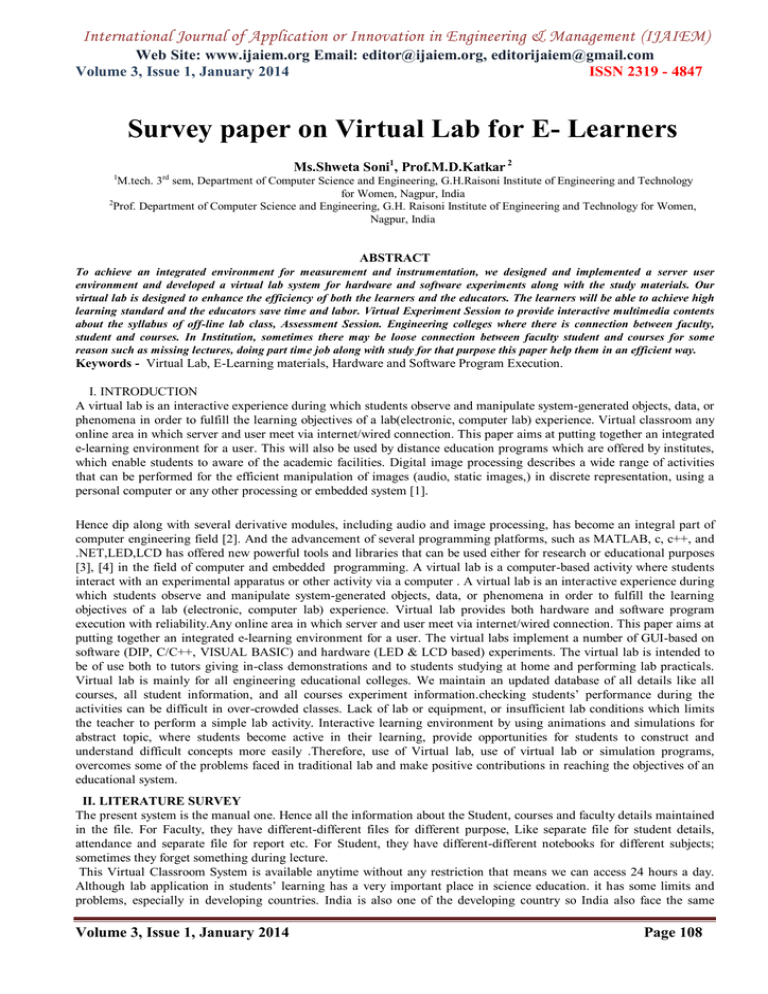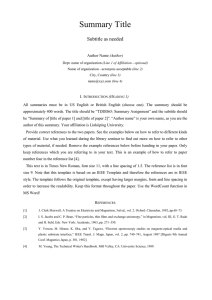International Journal of Application or Innovation in Engineering & Management... Web Site: www.ijaiem.org Email: , Volume 3, Issue 1, January 2014
advertisement

International Journal of Application or Innovation in Engineering & Management (IJAIEM) Web Site: www.ijaiem.org Email: editor@ijaiem.org, editorijaiem@gmail.com Volume 3, Issue 1, January 2014 ISSN 2319 - 4847 Survey paper on Virtual Lab for E- Learners Ms.Shweta Soni1, Prof.M.D.Katkar 2 1 rd M.tech. 3 sem, Department of Computer Science and Engineering, G.H.Raisoni Institute of Engineering and Technology for Women, Nagpur, India 2 Prof. Department of Computer Science and Engineering, G.H. Raisoni Institute of Engineering and Technology for Women, Nagpur, India ABSTRACT To achieve an integrated environment for measurement and instrumentation, we designed and implemented a server user environment and developed a virtual lab system for hardware and software experiments along with the study materials. Our virtual lab is designed to enhance the efficiency of both the learners and the educators. The learners will be able to achieve high learning standard and the educators save time and labor. Virtual Experiment Session to provide interactive multimedia contents about the syllabus of off-line lab class, Assessment Session. Engineering colleges where there is connection between faculty, student and courses. In Institution, sometimes there may be loose connection between faculty student and courses for some reason such as missing lectures, doing part time job along with study for that purpose this paper help them in an efficient way. Keywords - Virtual Lab, E-Learning materials, Hardware and Software Program Execution. I. INTRODUCTION A virtual lab is an interactive experience during which students observe and manipulate system-generated objects, data, or phenomena in order to fulfill the learning objectives of a lab(electronic, computer lab) experience. Virtual classroom any online area in which server and user meet via internet/wired connection. This paper aims at putting together an integrated e-learning environment for a user. This will also be used by distance education programs which are offered by institutes, which enable students to aware of the academic facilities. Digital image processing describes a wide range of activities that can be performed for the efficient manipulation of images (audio, static images,) in discrete representation, using a personal computer or any other processing or embedded system [1]. Hence dip along with several derivative modules, including audio and image processing, has become an integral part of computer engineering field [2]. And the advancement of several programming platforms, such as MATLAB, c, c++, and .NET,LED,LCD has offered new powerful tools and libraries that can be used either for research or educational purposes [3], [4] in the field of computer and embedded programming. A virtual lab is a computer-based activity where students interact with an experimental apparatus or other activity via a computer . A virtual lab is an interactive experience during which students observe and manipulate system-generated objects, data, or phenomena in order to fulfill the learning objectives of a lab (electronic, computer lab) experience. Virtual lab provides both hardware and software program execution with reliability.Any online area in which server and user meet via internet/wired connection. This paper aims at putting together an integrated e-learning environment for a user. The virtual labs implement a number of GUI-based on software (DIP, C/C++, VISUAL BASIC) and hardware (LED & LCD based) experiments. The virtual lab is intended to be of use both to tutors giving in-class demonstrations and to students studying at home and performing lab practicals. Virtual lab is mainly for all engineering educational colleges. We maintain an updated database of all details like all courses, all student information, and all courses experiment information.checking students’ performance during the activities can be difficult in over-crowded classes. Lack of lab or equipment, or insufficient lab conditions which limits the teacher to perform a simple lab activity. Interactive learning environment by using animations and simulations for abstract topic, where students become active in their learning, provide opportunities for students to construct and understand difficult concepts more easily .Therefore, use of Virtual lab, use of virtual lab or simulation programs, overcomes some of the problems faced in traditional lab and make positive contributions in reaching the objectives of an educational system. II. LITERATURE SURVEY The present system is the manual one. Hence all the information about the Student, courses and faculty details maintained in the file. For Faculty, they have different-different files for different purpose, Like separate file for student details, attendance and separate file for report etc. For Student, they have different-different notebooks for different subjects; sometimes they forget something during lecture. This Virtual Classroom System is available anytime without any restriction that means we can access 24 hours a day. Although lab application in students’ learning has a very important place in science education. it has some limits and problems, especially in developing countries. India is also one of the developing country so India also face the same Volume 3, Issue 1, January 2014 Page 108 International Journal of Application or Innovation in Engineering & Management (IJAIEM) Web Site: www.ijaiem.org Email: editor@ijaiem.org, editorijaiem@gmail.com Volume 3, Issue 1, January 2014 ISSN 2319 - 4847 problem. Some of the main problems faced can be summarized as follows: In carrying out experiments and arranging with equipment, the laboratory activities are expensive .For planning and application, it is much time consuming Checking students’ performance during the activities can be difficult in over-crowded classes. Lack of lab or equipment, or insufficient lab conditions which limits the teacher to perform a simple lab activity. Moreover they also overcome the possible dangers that can be seen in the real lab conditions (Yenitepe, 2001). For example a dangerous experiment for human health is prepared in computer as simulations, so that students can see the experiments design and perform the experiment in computer and observe the result. Other than performing dangerous, difficult or impossible experiments, simulations have advantages from the time, security, cost and motivation point of view (Rodrigues, 1997; Tekdal, 2002). VIRTUAL LAB FRAMEWORK From the above figure it shows the overall framework of virtual lab. On server side there is the one hardware experiment kit present for performing the hardware program. And which is connected to the server via wireless connection. for wireless connection we use zigbee module because it contain max signal rate(250 Kb/s) with low cost. And User devices is connected with centralize unit via weird/wireless connection. Using the virtual lab we can perform both hardware and software program very easily. In hardware program we can perform embedded program very easily. In traditional lab we face so many problems like Not User Friendly, Not Useful for E Learning Student, Lots of paperwork, Time consuming. So this problem can be solved by virtual lab we can overcome this problem by using virtual lab. Therefore, use of VR in labs, in other word, use of virtual lab or simulation programs, overcomes some of the problems faced in traditional laboratory applications and make positive contributions in reaching the objectives of an educational system. 2.1 The Comparative study of traditional Lab & Virtual Lab: Educators made a comparison between the traditional lab & virtual lab. No. 1 2 3 4 5 6 7 8 9 Characteristics of education in Traditional Lab Closed educational environment In college lab the book & the teacher are the main sources of knowledge Separating between the theoretical & practical, and between the real & imagination. College lab provides the standardized official education Teaching the whole class in large group. College lab depends on traditional method. The individual differences are not considered in college lab. The teacher positivism, but negativism of the learner. Verbal teaching methods Volume 3, Issue 1, January 2014 Characteristics of education in Virtual Lab Flexible & opened educational environments. In virtual lab education depends on varied resources & multimedia. The integral between the theoretical & practical aspect in virtual situations that stimulates Reality. Virtual lab provides Continuous learning lifetime Teaching the whole class through small or individual groups. Virtual lab depends on Varied methods of teaching. The individual differences are considered in Virtual lab. Positive and active participation from both instructor and learner. Varied teaching & learning methods. Page 109 International Journal of Application or Innovation in Engineering & Management (IJAIEM) Web Site: www.ijaiem.org Email: editor@ijaiem.org, editorijaiem@gmail.com Volume 3, Issue 1, January 2014 ISSN 2319 - 4847 In virtual lab we can perform and uses GUIs to implement several interactive exercises, giving students practical experience of important theoretical aspects of multimedia processing. The main objective of this Virtual Lab is to immerse the student in the related theoretical topics, starting with very fundamental concepts and progressively and hierarchically building up his/her Knowledge to the level of current state-of-the-art approaches. The MASTERS Virtual Lab is intended to be of use both to tutors giving in-class demonstrations and to students studying at home and performing laboratory practical’s [3]. In-class demonstrations using the interactive MASTERS’ GUIs can complement lectures, offering an immediate visual interpretation of the concepts discussed. The MASTERS Virtual Lab is accompanied by a detailed manual that provides an essential summary of the theoretical concepts behind each experiment, describes the structure and functionality of each GUI, and provides a set of unworked exercises that can be used as homework assignments. III. CONCLUSION Virtual lab have been presented an innovative solution to developing and enhancing lab practice and access for distance learners, and as a means of providing training and experience for teaching Lab. Virtual lab Reduces work and time. It provides User friendly screens to enter the data. Virtual lab is web enabled portable and flexible for further enhancement.This project can be highly beneficial for students who want to continue their study from e-learning programmes. Virtual lab provides the basic knowledge To the student who doesn’t have any idea about the experiment. Virtual Lab adopts technologies from a wide range of fields. References [1] Rajnish Kumar, Swati Shahi ”Virtual Classroom System” International Journal of Engineering Trends and Technology (IJETT) - Volume4 Issue4- April 2013 [2] Huda Mohammad Babateen” The role of Virtual Laboratories in Science Education” 2011 5th International Conference on Distance Learning and Education IPCSIT vol.12 (2011) IACSIT Press, Singapore [3] Dimitrios S. Alexiadis ,Nikolaos Mitianoudis “MASTERS: A Virtual Lab on Multimedia Systems for Telecommunications, Medical, and Remote Sensing Applications “IEEE Transactions On Education, Vol. 56, No. 2, May 2013. [4] U. Rajashekar, G. C. Panayi, F. P. Baumgartner, and A. C. Bovik, “The SIVA demonstration gallery for signal, image, and video processing education,” IEEE Trans. Educ., vol. 45, no. 4, pp. 323–335, Nov. 2009. [5] S. Shearman, S. Hong, and E. Perez, “To improve signal processing concept demonstration software, consider the interactive experience, “in Proc. 13th IEEE DSP & 5th IEEE SPE, 2009, pp. 227–231. [6] S. Mitra, Digital Signal Processing. New York: McGraw-Hill, 2011. [7] J. H.McClellan, R. W. Schafer, andM. A. Yoder, “A changing role for DSP education,” IEEE Signal Process. Mag., vol. 15, no. 3, pp. 16–18,May 1998. [8] U. Rajashekar, G. C. Panayi, F. P. Baumgartner, and A. C. Bovik, “The SIVA demonstration gallery for signal, image, and video processing education,” IEEE Trans. Educ., vol. 45, no. 4, pp. 323–335, Nov. 2002. [9] S. Shearman, S. Hong, and E. Perez, “To improve signal processing concept demonstration software, consider the interactive experience, “in Proc. 13th IEEE DSP & 5th IEEE SPE, 2009, pp. 227–231. [10] IHU, Thermi, Greece, “Medical IHU virtual labs multimedia in telecommunications and remote sensing applications,” 2012 [11] Y. Wang, J. Ostermann, and Y. Zhang, Video Processing and Communications. Upper Saddle River, NJ: PrenticeHall, 2002. [12] V. K. Goyal, “Theoretical foundations of transform coding,” IEEE Signal Process. Mag., vol. 18, no. 5, pp. 9–21, Sep. 2001. Volume 3, Issue 1, January 2014 Page 110






